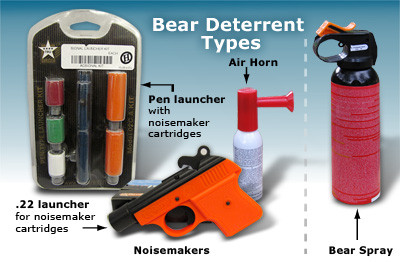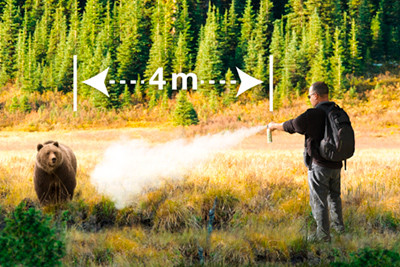Overview
People in bear country should be prepared to encounter a bear at any time. While following BearSmart practices can reduce the likelihood of an encounter, carrying and knowing how to properly use bear deterrents can help prevent injury if you do encounter a bear.
Bear deterrent types

The 2 most effective bear deterrents are bear spray and noisemakers. Carry both when in bear country.
Know when to use it
When I see a bear, know when to use a noisemaker or bear spray.
- Noisemakers are best used to deter a bear that is at a distance – one that sees you and continues to approach or one that is heading to your camp or settlement.
- Before using noisemakers, be sure to assess the situation. Make sure the surroundings are clear of people and the bear has an obvious way out. A bear that's been startled by a noisemaker may not be able to avoid groups of people as it flees the area.
- Remember, the noisemaker may not immediately deter the bear, especially if the bear has had previously experience with noise deterrents. Also, noisemakers may not prevent the bear from returning to the area.
- Bear spray is best used when you need to deter a bear at close range (see below).
Bear spray
Effectiveness
- No bear deterrent vendor can guarantee 100% success with their product. However, in a study of Alaska bear encounters, it was found that 98% of those who used bear spray were uninjured by the bear. The remaining 2% received only minor injuries that required no hospitalization (see study below).
- Compared to a firearm, bear spray is more effective at interrupting a bear attack and using it reduces the chance that you, or the bear will be injured (see study below).
- The active ingredient in bear spray is oleoresin capsicum, which irritates the eyes, nose and lungs, causing severe but temporary eye irritation and breathing difficulty.
- You must always be alert, diligent and prepared. Being BearSmart can prevent unwanted encounters from happening in the first place. Bear spray should be your last resort.
Buying bear spray
- Be sure the canister is labelled 'for deterring bear attacks.'
- The canister should weigh at least 225 grams (7.9 ounces).
- Check the canister's expiry date and replace it when necessary.
- Be sure to purchase a belt or chest holster to carry your bear spray. It's best to purchase a holster that closes across the top so the canister doesn't slip out.
- After making your purchase, be sure to remove the cable ties that keep the safety clip in place. If you forget to remove the cable ties, they will prevent you from removing the safety clip during a bear encounter.
Practicing bear spray use
Always read the information on the canister label to learn the specific spray range and duration of your product. Be sure to follow all instructions closely. Practice and be familiar with your can and holster combination.
- Practice reaching for your spray until you can retrieve it quickly. Practicing until you can retrieve your spray without thinking will help you respond effectively in a bear encounter.
- The best option is to practice with an inert canister, which has the same spraying power but not the hot pepper ingredient.
- If you practice with a new canister, you will use up some of the limited spray you may need in a bear encounter.
- Each canister of bear spray has a limited duration of bear spray, generally up to eight seconds. Read the label on your canister to find out how many seconds of spray yours contains.
- Take an in-person bear spray training course.
Storing bear spray
- Keep the canister away from items that could crush or puncture it.
- Never leave the canister in direct sunlight or anywhere temperatures can become very hot or very cold, such as in your vehicle.
- When driving, store the bear spray canister in a travel container. Once you have arrived, do not keep the bear spray in your vehicle. The variations in temperature can damage the canister.
- Bear spray cannot be transported on commercial airlines.
Carrying bear spray

- Keep the spray accessible. Carry it in a hip or chest holster, and not in your backpack or with your other gear.
- When biking or quadding, the best option is to keep the bear spray in a chest holster or jersey pocket.
- You can also modify the bear spray canister to fit inside the water bottle holder on your bike, or you can install a special bear spray mount. Remember, if you keep your bear spray on your bike or quad, you may not be able to reach it if you are separated from your bike or quad in a bear encounter.
- While sleeping, keep the spray next to your flashlight.
Using bear spray
Bears are normally wary of people and will leave if they know that you are in the area. If the bear sees you and continues to approach, prepare to deter it with your bear spray.
Bear spray is a proven deterrent, but you must know how to use it, and keep it on you in a belt or chest holster, not in your back pack or on your bike or ATV.
- Do not run. Stand your ground. Bring your group together.
- Prepare to use your bear spray by removing the safety clip.
- Evaluate the wind direction. Strong winds will affect your spray distance and direction. If possible, rotate so the wind is at your back.
- Speak in a calm voice.
- Attempt to leave the area slowly, backtracking on your route to where you came in, without turning your back to the bear.
- Remove the canister from the holster. Hold the canister with both hands.
- Aim low in front of the bear so the animal runs into the spray.

- When the bear is as close as 4 metres away (up to 13 feet) fire 1- to 2-second blasts in continuous succession, aiming just below the head, or into the nose and mouth of the bear until the bear leaves.
- If it's windy, bear spray may be blown in your direction.
- Be prepared to move out of the bear's way.
- Spray and react. Re-evaluate your situation.
- When the attack is interrupted, retreat. Do not run. Do not turn your back on the bear or try to chase the bear.
- As the bear leaves, do not follow it. Go in a different direction, or leave in the direction you came.
First aid treatment for bear spray
- Anyone who's been accidentally sprayed should be moved from the contaminated area to fresh air as quickly as possible.
- Flush exposed skin with cold water and soap. Mild, non-oil-based soaps such as baby soaps are best.
- Do not rub exposed areas. Pat dry with a towel.
- To flush spray out of your eyes, place your head under water and open your eyes every few seconds. Do not rub your eyes. Remove contacts lenses.
- Do not apply lotions or creams to the exposed areas.
- If the effects of the spray do not dissipate in 30 to 45 minutes, seek medical attention.
Noisemakers
The most effective noisemaker in bear country is you. Talking or singing loudly can help prevent surprise encounters with wildlife. With enough warning of your approach, wildlife typically remove themselves and their young from the area.
Types of noisemakers
- Airhorns: Easily carried in bear country; create a loud, piercing sound of greater than 120 decibels.
- Bangers: Available for pen-launchers, .22 caliber launchers, and 12 gauge launchers. Creates a loud bang after travelling 20 to 100 metres (66 to 328 feet).
- Screamers: Similar to bangers except they create a loud, continuous screeching noise for approximately 100 metres (328 feet). The flight pattern is erratic. Because these projectiles can be unpredictable, be extremely cautious when using them.
Using noisemakers
- Use noisemakers to scare away bears that are aware of your presence but do not leave the area.
- Do not use bangers or screamers in dry forest conditions. They can cause a fire.
- When aiming the noise deterrent, aim at the sky. Do not shoot it directly at the bear. Ensure it explodes between you and the bear. A noise deterrent that explodes behind the bear may startle it so the bear runs up in your direction.
- Be prepared to defend yourself with bear spray in case the noisemaker doesn't deter the bear.
Noisemaker safety
- Noisemakers that fire a projectile (bangers or screamers) should be stored and carried unloaded.
- Always be aware of the line of fire.
- Be aware of the potential for a ricochet.
- Never point or fire a noisemaker projectile at a person or an animal. This can cause injury or even death.
- Launchers must be stored in a clean location to prevent dirt from obstructing the launch point.
- Ensure you are not using bangers or screamers that are old, or that have been wet or altered in any way. They may prematurely explode and cause injury.